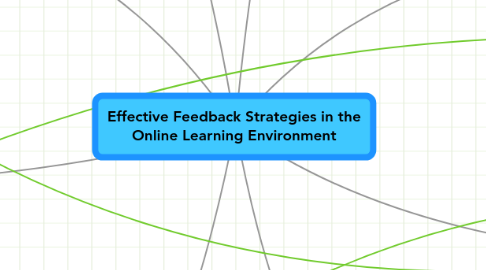
1. Teachers
1.1. Main source of formal feedback
1.2. Need awareness of strategies and tools to support effective online feedback
1.3. Important in providing feedback about
1.3.1. Learning progress
1.3.2. Identifying learning problems
1.4. Feedback function
1.4.1. Directive
1.4.1.1. About areas to fix
1.4.2. Facilitative
1.4.2.1. Comments and Suggestions that helps in learners revision, conceptualisation and reflection
1.5. Need to provide feedback that is
2. Importance of using online channels
2.1. Supports flexible delivery
2.2. Affordances
2.2.1. Multiple niche tools
2.2.1.1. Discussion Boards
2.2.1.1.1. Feedback
2.2.1.1.2. Feedforward
2.2.1.2. Email
2.2.1.2.1. Preferred as supplement to face-to-face teaching
2.2.1.3. Audio recording
2.2.1.3.1. Preferred over textual
2.2.1.3.2. Provides NVC clues
2.2.1.3.3. Can be less time consuming to create
2.2.1.4. Video recording
2.2.1.4.1. Combining two channels of (audio and visual) information produces 'deep' learning
2.2.1.4.2. Easier to follow corrections
2.2.1.4.3. Feeling of close contact with teacher
2.2.1.5. In-line Document notes
2.2.1.5.1. Embedded feedback is preferred
2.2.1.5.2. Can combine more information/communication channels
2.2.1.6. Auto-marked Quizzes
2.2.1.6.1. Useful for simple tasks
2.2.1.6.2. Support learners need for
2.2.1.7. Synchronous aggregrators
2.2.1.7.1. Virtual Classrooms can combine all channels to create similar 'experience' to classroom
2.2.1.7.2. Tool can be selected to provide rich formative feedback
2.2.2. built on constructivist paradigm
2.2.3. Recorded
2.2.4. Can be created in a safe 'sandpit'
2.2.5. Provide distance
2.2.6. Provide channels to MKO's
3. Timing of feedback
3.1. Needs to be determined by
3.1.1. Level of difficulty
3.1.2. Objective of learning activity
3.2. Immediate
3.2.1. Learner engaged in performing a learning activity
3.2.2. Innterruptive, distractive and demotivating to building frequency
3.2.2.1. Depending on judgement about
3.2.2.1.1. When
3.2.2.1.2. How
3.2.2.1.3. Level
3.3. formative
3.3.1. Helps teacher provide
4. Peers
4.1. Accepted as promoting growth by
4.1.1. Age-groups
4.1.2. Disciplines
4.1.3. Geographic boundaries
4.2. Strengthens learners performance by
4.2.1. Opportunities
4.2.1.1. Timeliness of feedback
4.2.1.2. Learn about evaluation process
4.2.1.3. Removes dependence on single-source of judgement
4.2.1.4. Highlights alternative perspectives, tactics and strategies
4.2.1.5. Providing learning opportunities for the mentor
4.2.2. Online Challenges
4.2.2.1. students less likely to interact or engage
4.2.2.2. Lack of interaction can limit communication of complex ideas
4.2.2.3. Divide in computer skills can disadvantage some learners
4.2.2.4. Anxiety when giving or receiving feedback
4.2.2.5. Validity/Reliability
4.2.2.6. Less valued than teacher feedback
4.2.3. Solutions
4.2.3.1. Well designed assignments
4.2.3.2. Setting clear expectations through exemplars and ribrics
4.2.3.3. Student discussion of criteria
4.2.3.4. Qualitative feedback on strengths and weaknesses - rather than grades alone
4.2.3.5. Providing feedback on feedback
4.2.3.6. Global marks as opposed to many individual dimensions
4.2.3.7. Encouraging reinforcing feedback, avoiding didactic feedback
4.3. Debate of effectively implementing
4.3.1. Anonymity
4.3.1.1. Voice unbiased critiques
4.3.2. 'Buddies'
4.3.2.1. Inclusive
4.3.2.2. Accountability
4.3.3. Numbers
4.3.3.1. Large numbers not more accurate
4.3.3.1.1. +4 required
4.3.3.2. Small
4.3.3.2.1. increases responsibility of providing quality feedback
4.3.3.2.2. Reciprocity
4.4. Provide
4.4.1. Greater
4.4.1.1. Immediacy
4.4.1.2. Frequency
4.4.1.3. Volume
4.4.2. Less
4.4.2.1. Quality
4.4.3. Different types of feedback to experts
4.4.3.1. Teaching tone less effective
4.4.3.2. Reinforcing promoted growth
4.4.3.3. Early feedback in the process was more effective
4.4.3.4. Feedback dependent on type of student
4.5. Utilise Online feedback through
4.5.1. Online Portfolios
4.5.2. Conference track
4.5.3. Multi-modal texts
4.5.4. Teacher created feedback forms or anonymous survey tools
4.5.5. Peer research/resource sharing to promote collaboration and refine ideas
4.5.6. Peer editing
4.6. Need up-to-date ICT tools
4.7. Validity questionable because of inconsistent
4.7.1. language
4.7.2. Study groups
4.7.2.1. Age
4.7.2.2. Group size
4.7.2.3. Discipline
4.7.3. Criteria to interpret data
5. Reflective practices
5.1. Are a powerful learning agent
5.2. Work at the highest cognitive processes
5.3. Widen your frame of reference
5.3.1. Allowing transformative change
5.4. Create a state of anxiety and discomfort
5.5. Are difficult because
5.5.1. Complexity of teaching elements including
5.5.1.1. Institutional barriers
5.5.1.2. Shift from Positivist to constructivist teaching methods
5.5.1.3. Student learning styles
5.5.1.3.1. Diffentiated Instruction
5.6. Supported through
5.6.1. Learning tasks
5.6.2. Learning resources
5.6.3. Learning supports
5.6.3.1. Conative
5.6.3.2. Scaffolds
5.6.3.3. Social support
5.6.4. Guided Inquiry
5.7. Enables Life-long learning
5.7.1. Allows the Self-Directed Learner to frame problems
6. Aim of Feedback
6.1. Closes the gap between current and desired performance
6.1.1. Because it improves learning transfer
6.2. Supports Self-Reflection and Self-Directed Learning
7. Components of effective feedback
7.1. Highlights good performance
7.2. Compares performance
7.3. Closes the gap
7.3.1. Supported through
7.3.1.1. Task
7.3.1.2. Process
7.3.1.3. Self-Regulation
